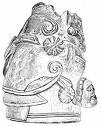One of the World's Leading
Sources of Information On Literature, the Arts, and a Wide Range of
Subjects
Some Confirmation of the History
(This is taken from John D. Baldwin's Ancient America, originally published in 1871.)

That the ancient history of the country was something like what is reported in the old writings seems not improbable when we consider the condition in which the native population was found three hundred and fifty years ago. This shows that Mexico and Central America had been subjected to disrupting political changes caused by violent transfers of supreme influence from one people to another several times in the course of a long history. Such a history is indicated by the monuments, and its traces were noticeable in peculiarities of the native inhabitants of the various districts at the time of the Spanish Conquest. They are still manifest to travelers who study the existing representatives of the old race and the old dialects sufficiently to find them. There were several distinct families or groups of language, and, in many cases, the people represented by each family of dialects were in a state of separation or disruption. To a considerable extent they existed in fragmentary communities, sometimes widely separated.
The most important group of related dialects was that which included the speech of the Mayas, Quichés, and Tzendals, which, it is supposed, represented the language of the original civilizers, the Colhuas. Dialects of this family are found on both sides of the great forest. There were other dialects supposed to indicate Toltec communities; and there were communities south of Mexico, in Nicaragua, and even farther south, which used the Aztec speech. Very likely all these differing groups of language came originally from the same source, and really represent a single race, but comparative philology has not yet reported on them. Mention is made of another people, called Waiknas or Caribs, and conjecture sees in them remains of the aboriginal barbarians termed Chichimecs. They dwelt chiefly in the “dense, dank forests” found growing on the low alluvion of the Atlantic coast. So far as is known, their speech had no affinity with that of any other native community. People of this race constitute a chief element in the mixed population of the “Mosquito Coast,” known as Moscos.
In Yucatan the old inhabitants were Mayas, and people using dialects related to theirs were numerous in Tabasco, Chiapa, Guatemala, and the neighboring districts, while all around the country were scattered communities supposed to be of Toltec origin, as their speech could not be classed with these dialects nor with that of the Aztecs. The most reasonable explanation of this condition of the people is that furnished by the old chronicles and traditions. The country must have been occupied, during successive periods, by different peoples, who are represented by these broken communities and unlike groups of language. When all the native writings still in existence shall have been translated, and especially when the multitude of inscriptions found in the ruins shall have been deciphered, we may be able to see in a clearer light the ruins, the people, and their history.
Home | Book Collecting | Folklore / Myth | Philately | Playing Cards | Literature | Contents
